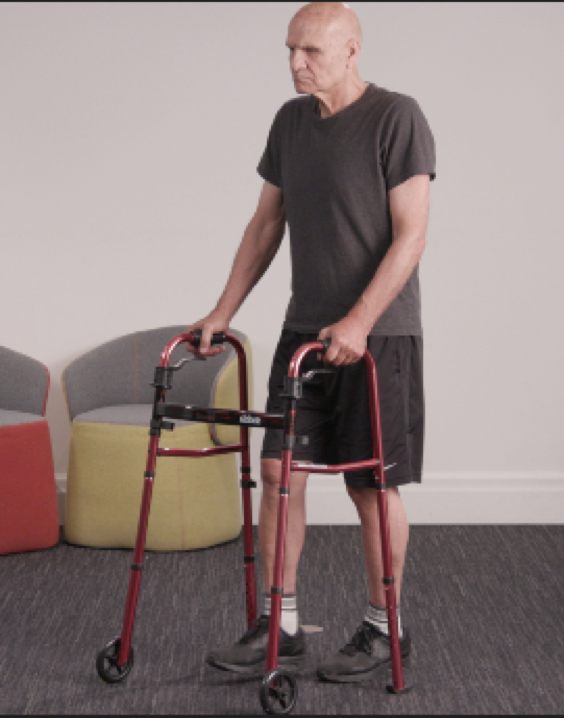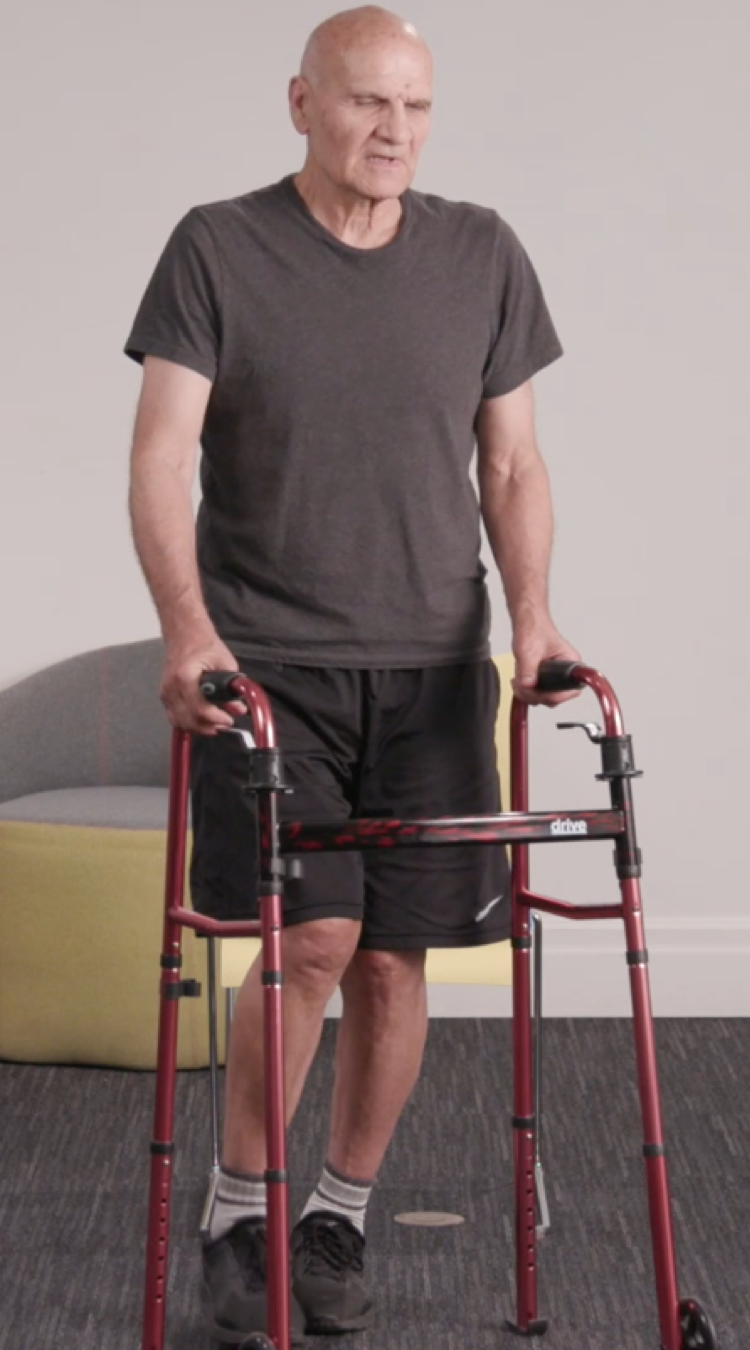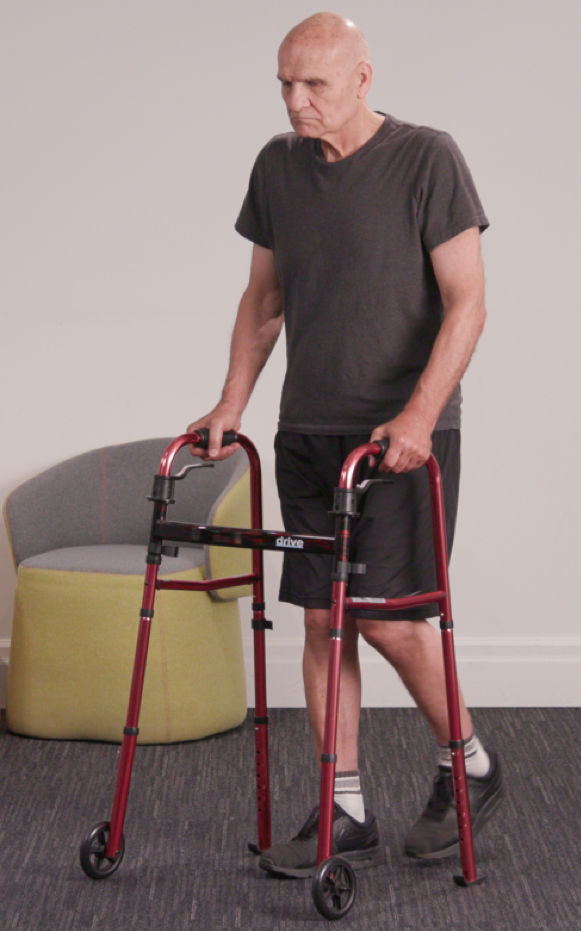Note: This blog is a continuation from a previous blog discussing sitting, standing and getting in and out of bed that you can read here!
After a hip replacement or knee replacement knee replacement it is very common to use a walker. As I previously discussed in part 1; how to use a walker and safety tips , the kind of walker you will be using will depend on your stability, weight bearing status and strength to be able to operate it. Regardless of which walker you are using, understanding how you should move and what movements you should avoid is important to maintain the integrity of the surgically repaired joint and allow for proper healing. In this blog I will discuss how to use your walker safely in a variety of everyday scenarios such as walking, turning and getting in and out of your car.
Post surgery precaution reminder
Before reading this blog it is important to understand that if your surgeon has given you any precautions after a hip replacement it is important to follow them. These precautions are:
- Avoid flexing your hip above 90 degrees, where your knees are above your hips [3]
- Avoid adducting your leg past the midline of your body, where your leg is past your imaginary midline [3]
- Avoid internally rotating your hip, where your knee is pointing to the middle of your body [3]
Be aware of these when doing the movements below. Some surgeons do not require you to have specific movement precautions after hip replacement. In both cases, hip replacement with or without movement precautions, you can safely use the information below to learn how to use your walker.
It is uncommon for someone recovering from a knee replacement or ACL surgery to be given precautions after surgery. If you have been given any precautions after surgery they are usually very specific to your surgeon or the procedure. If you have been given a precaution from your surgeon follow them closely. These precautions usually are about how much weight you can load on your knee, how much you can bend your knee, and to avoid twisting your knee. [2] Following the instructions in this step-by-step guide will make sure you are adhering to these precautions.
It is important to note at all times adhere to the weight-bearing orders your rehab team has assigned. To help reduce weight off your surgically repaired leg when standing or sitting, straighten that leg out and use your good leg and both arms to do the work. [1][5] This is shown in the picture below.

Learning how to get into and out of your car properly
Getting into your car step by step
- Before approaching the vehicle get someone to move your seat as far back as possible and in a reclined position[4]
- Position yourself with your back facing the car, feel the back of your legs against the car and reach for the sides of the car for support[4]
- Begin to lower yourself down until you feel your buttock on the seat[4]
- Once in this seated position with your legs still pointing out of the car, slide back as far as you can[4]
- Once this has been done swing your legs in one at a time until you are in the car[4]
Note for hip precautions: To make sure your operated leg doesn’t move past the midline of your body carefully use your arms to guide your leg into your car.[5]
Getting out of your car step by step
- Have someone open the car and position your walker outside the open door of your car[4]
- Slowly lift your legs and move them to point outside the car door[4]
- Use your arms to push yourself to the edge of your seat and slowly put your legs into contact to the ground[4]
- Lean forward and push off with your arms to help get you up[4]
- Once standing place your hands on your walker securely and stand up straight[4]
Note for hip precautions: To make sure your operated leg doesn’t move past the midline of your body carefully use your arms to guide your leg out of your car.[5]
Note for hip precautions: Do not excessively lean when sitting up, try and stay as upright as possible when getting up.[5]
Walking properly with your surgically repaired leg
“Step to” pattern step by step
This pattern of walking is done when you are trying to reduce the amount of weight on the operated limb. You may be told by your physical therapist that you are going to use a “step to” pattern to walk
- Move your walker forward a small distance, roughly one step
- Step forward with your operated leg and at the same time put weight through your hands into the walker to help take stress off of this leg
- With your good leg push off and take a step to the distance of your injured leg's foot
Note for knee precautions: Do not internally or externally rotate your knee when walking which means do not let your kneecap point inwards or outwards. To avoid this concentrate on keeping your kneecap pointing forward while walking.[2]
Note for everyone: The entire time keep your feet within body of the walker

“Step through” pattern step by step
This pattern of walking is done when you are able to put a more normal amount of weight through your operated limb. You may be told by your physical therapist that you are going to use a “step through” pattern to walk.
- Move your walker forward a small distance, roughly one step
- Step forward with your operated leg and continue to push the walker forward as you take a step with your non-operated leg
- Continue to move the walker forward as you step and repeat the above pattern
Note for knee precautions: Do not internally or externally rotate your knee when walking which means do not let your kneecap point inwards or outwards. To avoid this concentrate on keeping your kneecap pointing forward while walking.[2]
Note to everyone: This should resemble closely your usual walking pattern.

How to turn and use the seat of your walker
How to turn step by step
Tight turn method
- Move the walker slightly to the side using your arms[1]
- Slowly move your legs until your body is back in line with the walker
- Repeat this until you are fully turned around
Note for hip precautions: Do not let your hip internally rotate which means twisting your leg so your knee cap is pointing inwards. To avoid this carefully walk in a large circle and do not turn at any significant angle.[5]
Note for knee precautions: Do not internally or externally rotate your knee when walking which means do not let your kneecap point inwards or outwards. To avoid this concentrate on keeping your kneecap pointing forward while walking.[2]
Large turn method
- Begin walking in a circle at a wide angle[1]
- Continue to do so until you have completely turned around
Note to everyone: This method is preferred after surgery for hip replacements, knee replacements and ACL surgeries to avoid any twisting of the hip and knee joints.

Using the seat on your walker step by step
- Position your walker against a wall or a stable surface IF possible
- Put the brakes on your walker
- Stay beside your walker, turn around and move your hands to safely hold the handles
- Make sure the back of your legs are against the seat of the walker
- Slowly lower yourself down, do not rely on the walker or hold the walker for support
Note to everyone: If you do not have the strength or coordination to lower your body down with all of your weight on your legs you should not use the seat on your walker
For more information about how to use a walker after a knee replacement or hip replacement, check out the following blogs:
- How to use a walker and safety tips part 1: Learning the basics
- How to use a walker and safety tips part 2: Sitting, standing and getting in and out of bed
- How To Use a Walker and Safety Tips Part 4: Learning How To Fall
Conclusion
This blog discusses how to use your walker safely in a variety of everyday scenarios such as walking, turning and getting in and out of your car. We've also written a great blog with a step by step guide on how to shower and go to the washroom after a knee replacement.
For more information about knee replacements and hip replacements check out Curovate. Curovate is a physical therapy app that allows you to track your rehabilitation progress!
If you need further customized assistance during your surgery or injury recovery check out our Virtual Physical Therapy page to book your 1-on-1 video session with a physical therapist.
References
1 Cleveland Clinic medical professional. (2019). How to use a walker.
2 Lompoc Valley Medical Center. (N.d.). Total knee precautions.
3 Physiopedia. (N.d.). Hip precautions.
4 Saint Luke's. (N.d.). Hip safety: Getting into and out of a car.
5 Sunnybrook Holland Centre. (2021). A guide for patients having hip or knee replacement.
 |
 |
|---|







